Best Mediterranean plants: 16 sun-loving options to try
Drought-tolerant Mediterranean plants make great gap fillers, climbers and architectural specimens to bring exotic glam to your garden


The right Mediterranean plants give us a chance to bring the charms of summers abroad into our own gardens. Travelling abroad, we will all have gazed in awe at palms, citrus trees, bougainvillaea and oleander.
Hot summers and mild winters characterize countries bordering the Mediterranean sea and also California, parts of South Africa and Chile, plus a small slice of Western Australia; and these areas often have poor, thin soils.
Planning a Mediterranean-style space is easy, if you start with the larger backbone plants, focusing on shapes and year-round effects. Smaller flowering plants then fall into place and fill the gaps.
Plants with fan-like or long pointed leaves strike a pose in the garden and there are several hardy palms worth a try in milder areas. Like monkey puzzle trees, they take up more space when young because their spreading leaves are close to the ground. With maturity, the long leaves of date palms (phoenix) and the fans of chamaerops are held aloft on tall trunks composed of old leaf bases. Torbay palms (cordyline australis), silvery astelia and yucca have the same effect (cultivars of Y.flaccida are of modest size and have softer leaf tips).
Those with greenhouses or conservatories can add tender birds of paradise, bougainvillaea and cassia. These stand out for summer, but enjoy frost protection for winter.
There are also hardy plants available to bring the look of a Mediterranean garden to your yard. Use hummock-forming plants including lavenders and cotton lavender (Santolina chamaecyparissus) in groups to cover the ground with undulating mounds. Such plants add a Mediterranean flourish to flower beds and many work well in containers.
Olive trees set the scene and mature plants can survive from 14 to 23˚F (-5 to -10˚C), although a cold winter will take its toll. The hardier deciduous oleaster (Elaeagnus ‘Quicksilver’) makes a good olive lookalike.
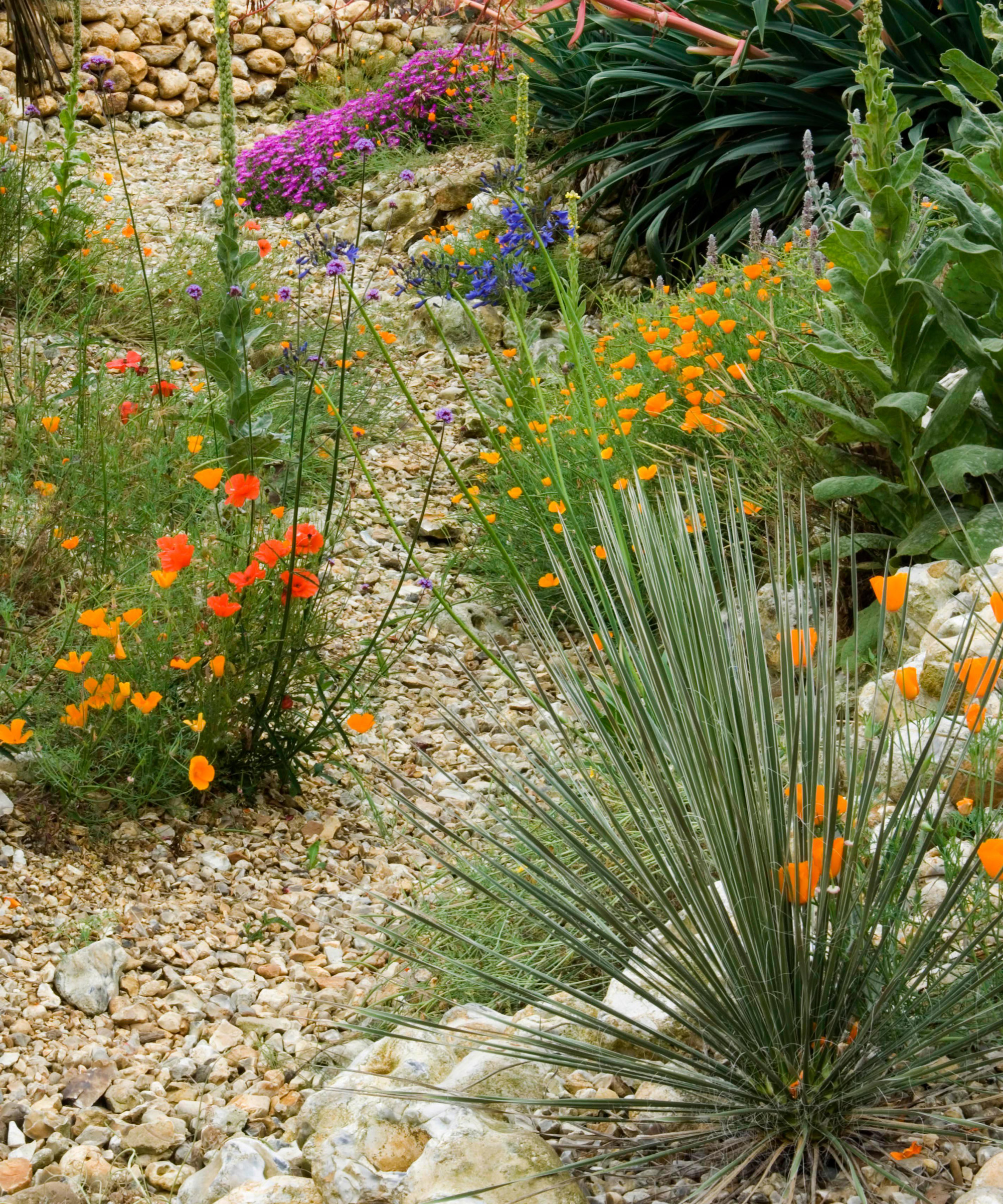
Add texture and drama with these Mediterranean plants
By choosing the right plants, you can easily bring a touch of the Mediterranean to your garden. As well as bringing a wide range of shapes and colors, these drought-tolerant plants are adjusted to thrive in hot, sunny climates.
With your own soil type and climate firmly in mind, decide which Mediterranean plants will best suit your design. These 16 plants include ideas for garden borders and pots, from dainty flowering options to towering architectural palms.
1. Agapanthus ‘Arctic Star’ AGM
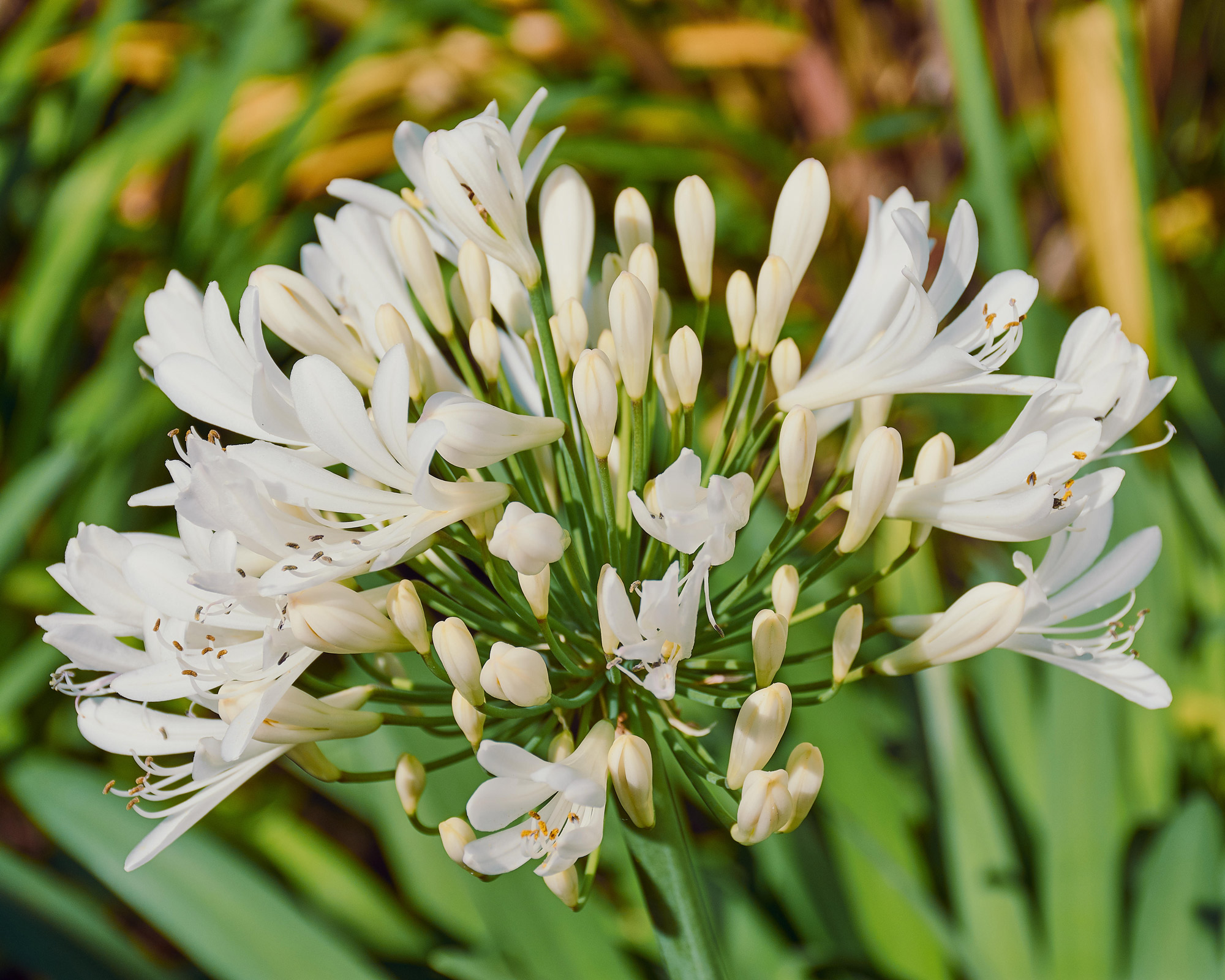
- Hardiness: USDA 8b/9a
- Height: 3ft (1m)
- Best for: container growing
Although originally from South Africa and known as African lily, the tender evergreen Agapanthus praecox has strong associations with Madeira where it grows wild. It’s a striking choice for those wanting a dramatic garden with punchy white florals.
To get the look, choose a type with large flower heads – for colder gardens, stick to tougher deciduous types.
Agapanthus ‘Arctic Star’ AGM is a semi-evergreen cultivar bearing white flowers that are 9in (23cm) across. These Mediterranean plants thrive in containers.
2. Cistus x purpureus AGM
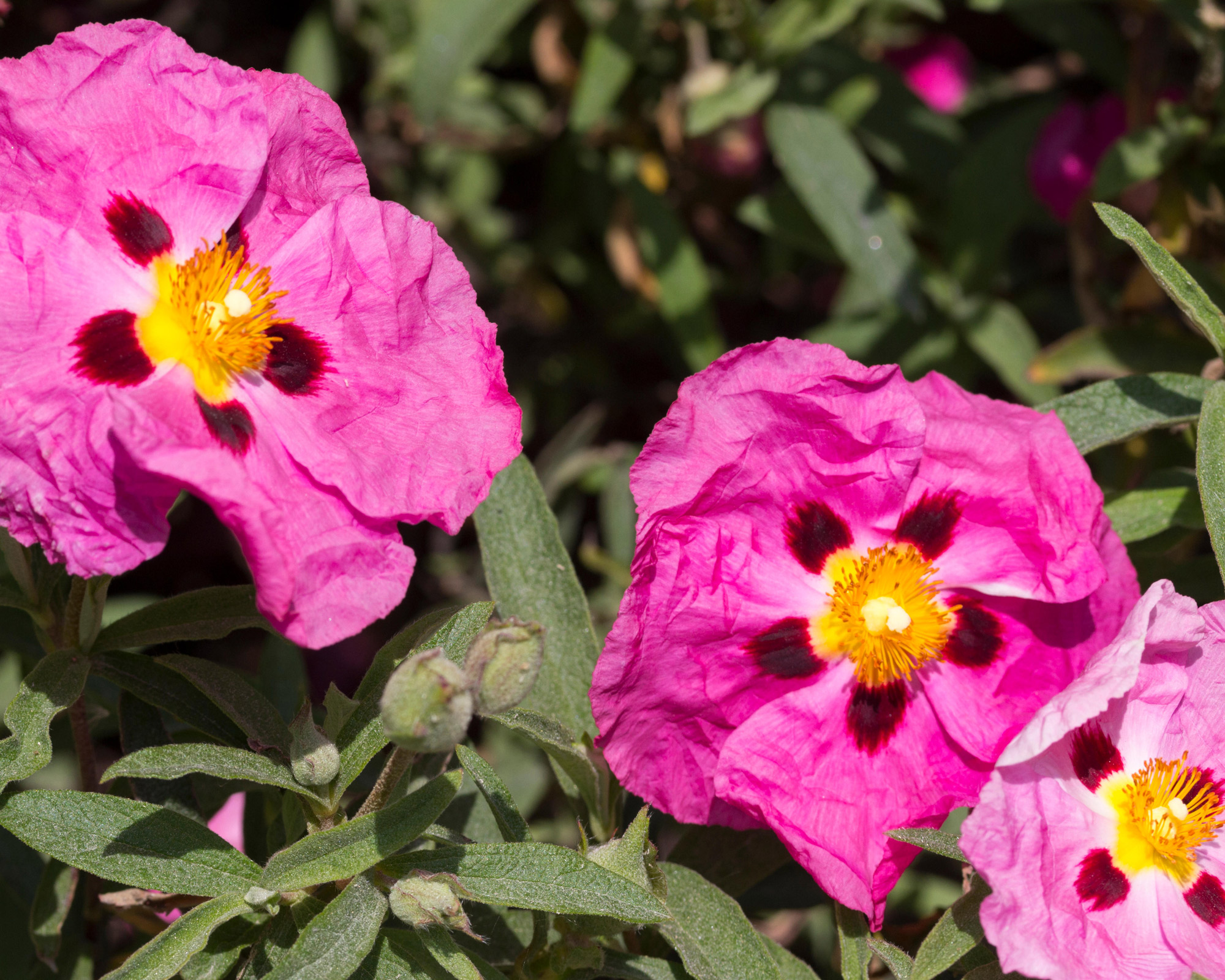
- Hardiness: USDA 8b/9a
- Height: 5ft (1.5m)
- Best for: drought-tolerant roses
If you are looking for Mediterranean plants that afford a vibrant splash of color, Cistus x purpureus offers just the thing. Lovers of more unusual types of roses are sure to love rock roses, a group of drought-tolerant shrubs that are perfectly adapted to survive sizzling hot summers.
This hybrid between C. ladanifer and C. creticus bears narrow leaves and lights up in summer with purple-pink flowers decorated by darker blotches. Give these cistus varieties sunshine and well-drained soil, and if necessary prune after flowering but never into old wood.
3. Choisya ‘White Dazzler’ AGM
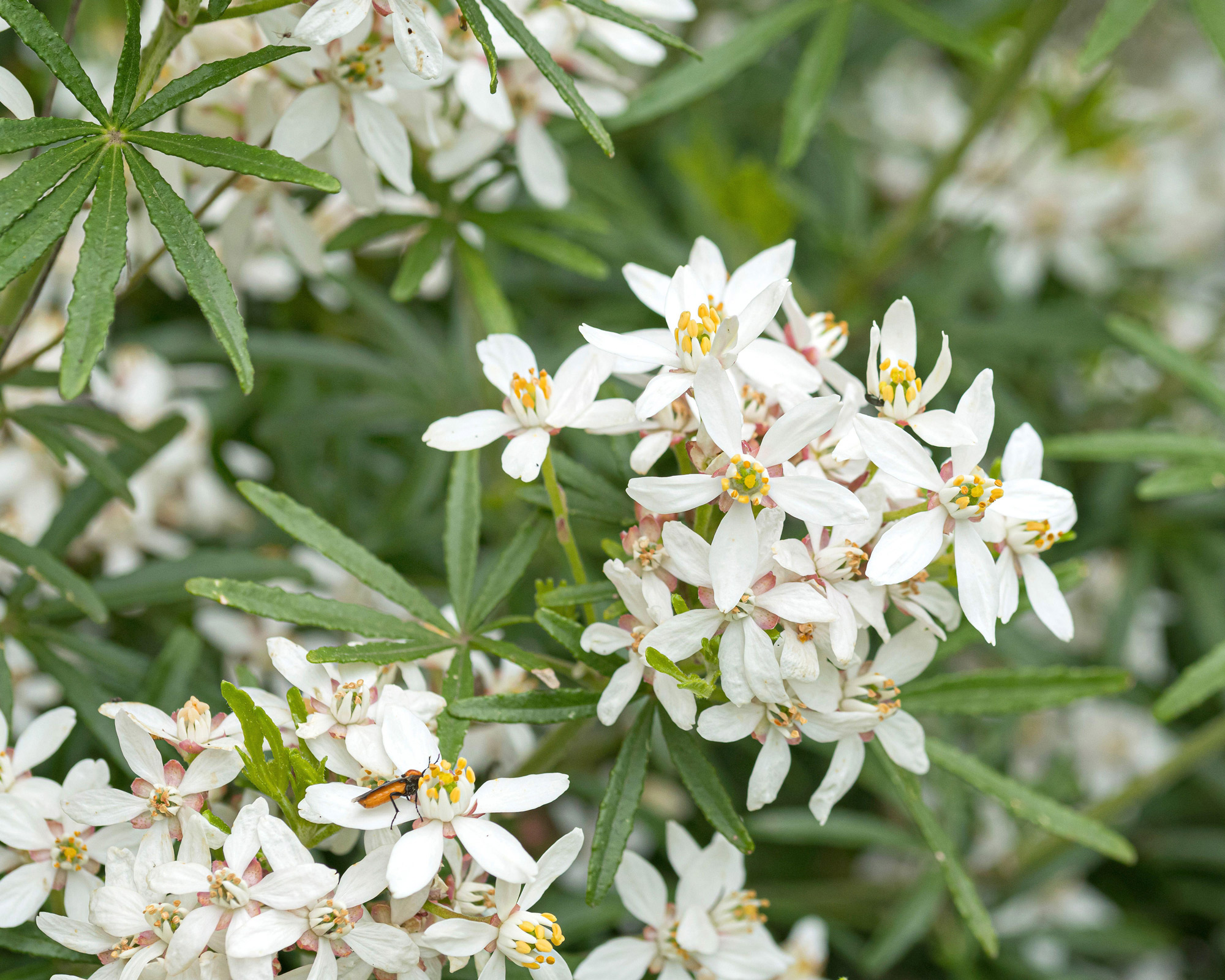
- Hardiness: USDA 8b/9a
- Height: 3ft (1m)
- Best for: compact evergreens
Citrus is often cited as one of the most definitive Mediterranean plants. Evocative, fragrant and among the best fruit trees to grow in pots, they rank highly in Med-style landscaping. However, true citrus plants (with the exception of the Japanese bitter orange) are not frost hardy, so why not grow a Mexican orange (choisya) instead?
Choisya x dewitteana ‘White Dazzler’ AGM is a compact evergreen shrub. It opens delightful fragrant white flowers in spring and late summer and these last all the way through to fall, against divided, aromatic foliage.
4. Cupressus sempervirens ‘Totem Pole’
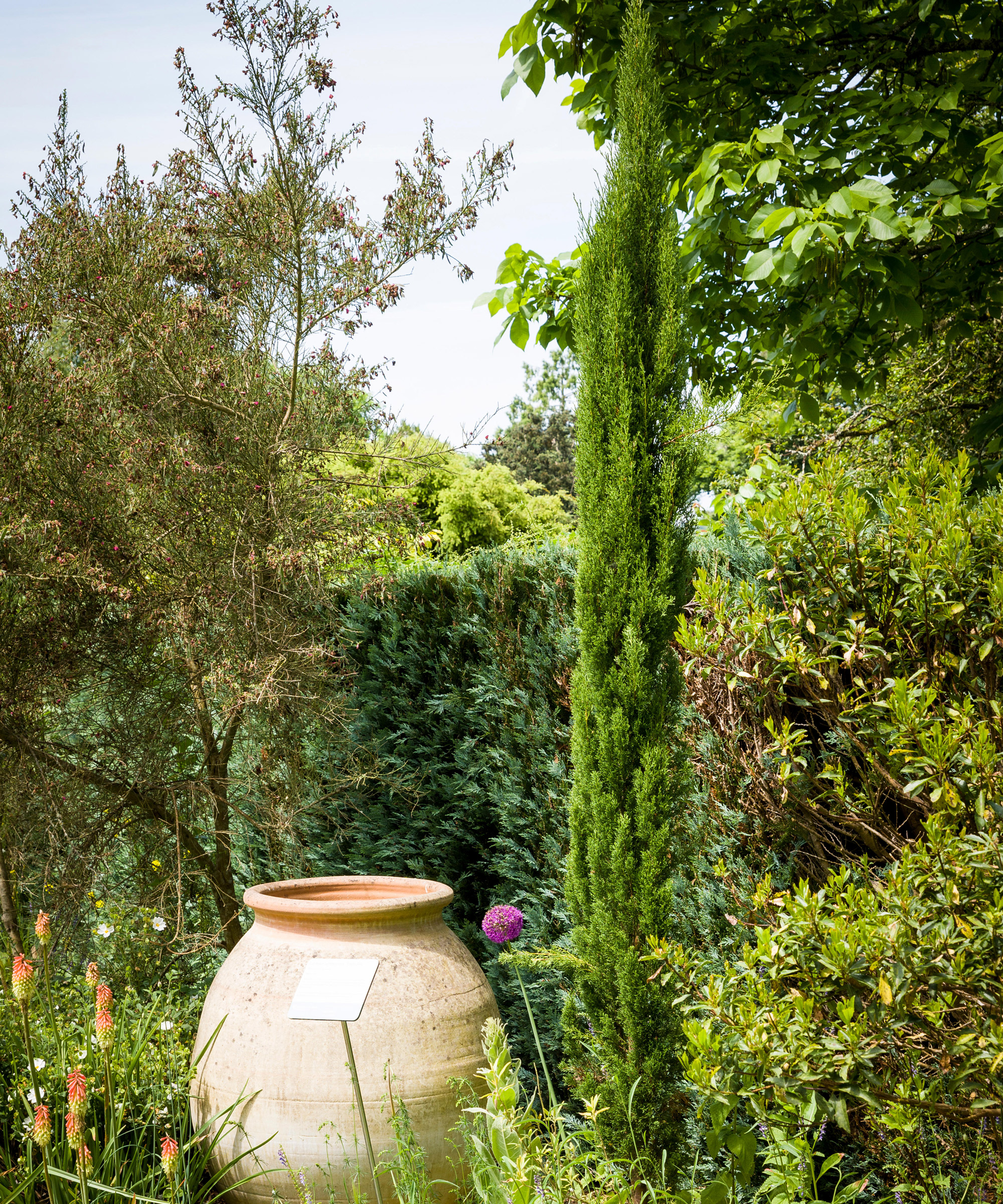
- Hardiness: USDA 7b/8a
- Height: 30ft (9m)
- Best for: columnar growth
Anyone who has travelled through Italy – in particular Tuscany - will have admired the narrow, columnar conifers set along driveways and wherever there are houses, vineyards and gardens. So if you are looking for a typically Mediterranean way of landscaping with evergreens, this plant is ideal.
Cupressus sempervirens are iconic cypress trees that grow tall and wide. ‘Totem Pole’ is a narrow cultivar that suits smaller plots and will take its time to reach a mature height.
5. Iberis ‘Masterpiece’
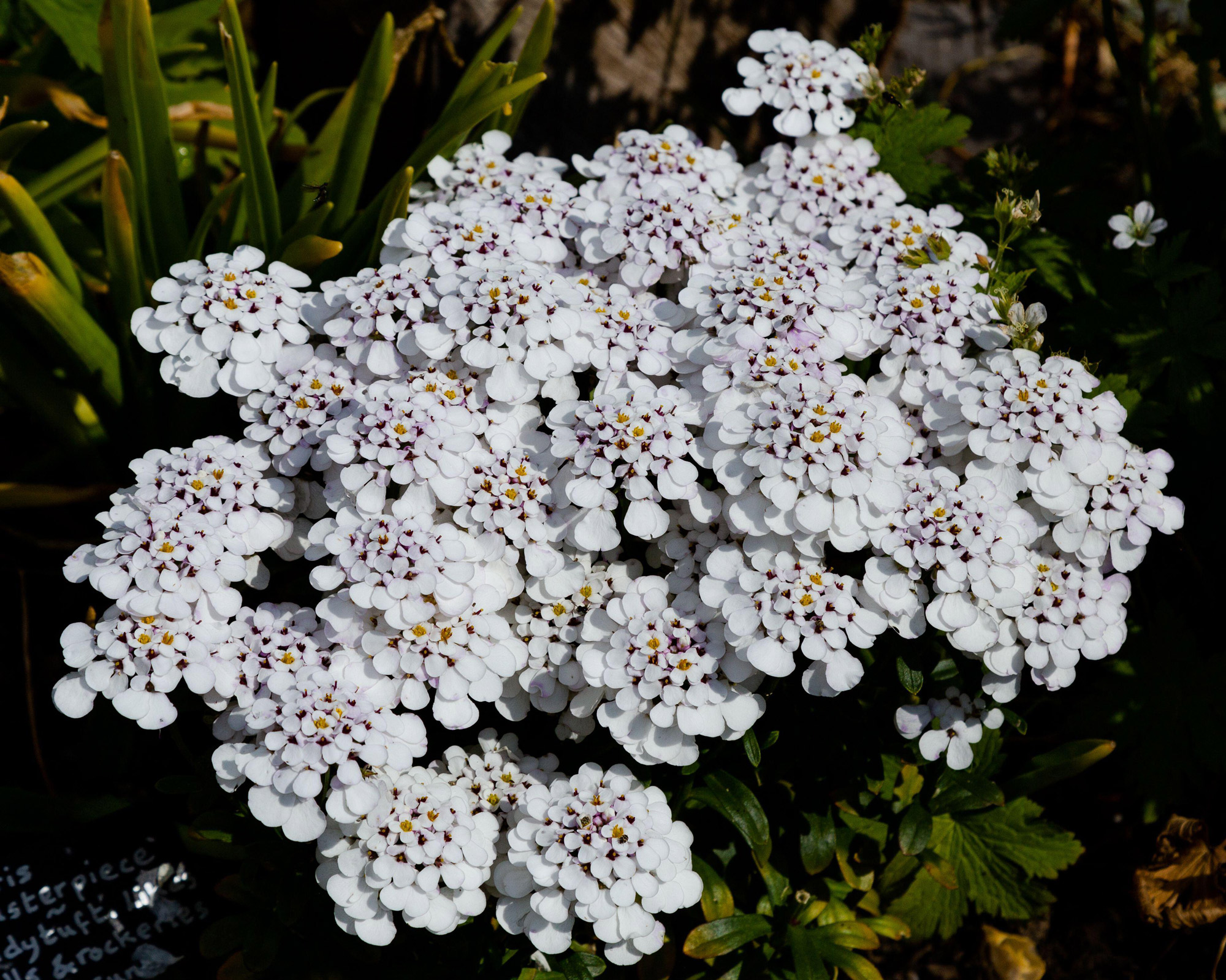
- Hardiness: USDA 7b/8a
- Height: 12in (30cm)
- Best for: white flowers
Iberis ‘Masterpiece’ is a large-flowered cultivar of perennial candytuft with a woody base that makes a low, evergreen mound of dainty, bright green leaves.
During spring and summer, these plants are smothered by generous clusters of white flowers with yellow stamens. They are sun-lovers that thrive best in poor, well-drained soil, and they benefit from a light trim after flowering to help keep growth compact.
6. Lavandula angustifolia ‘Hidcote’ AGM
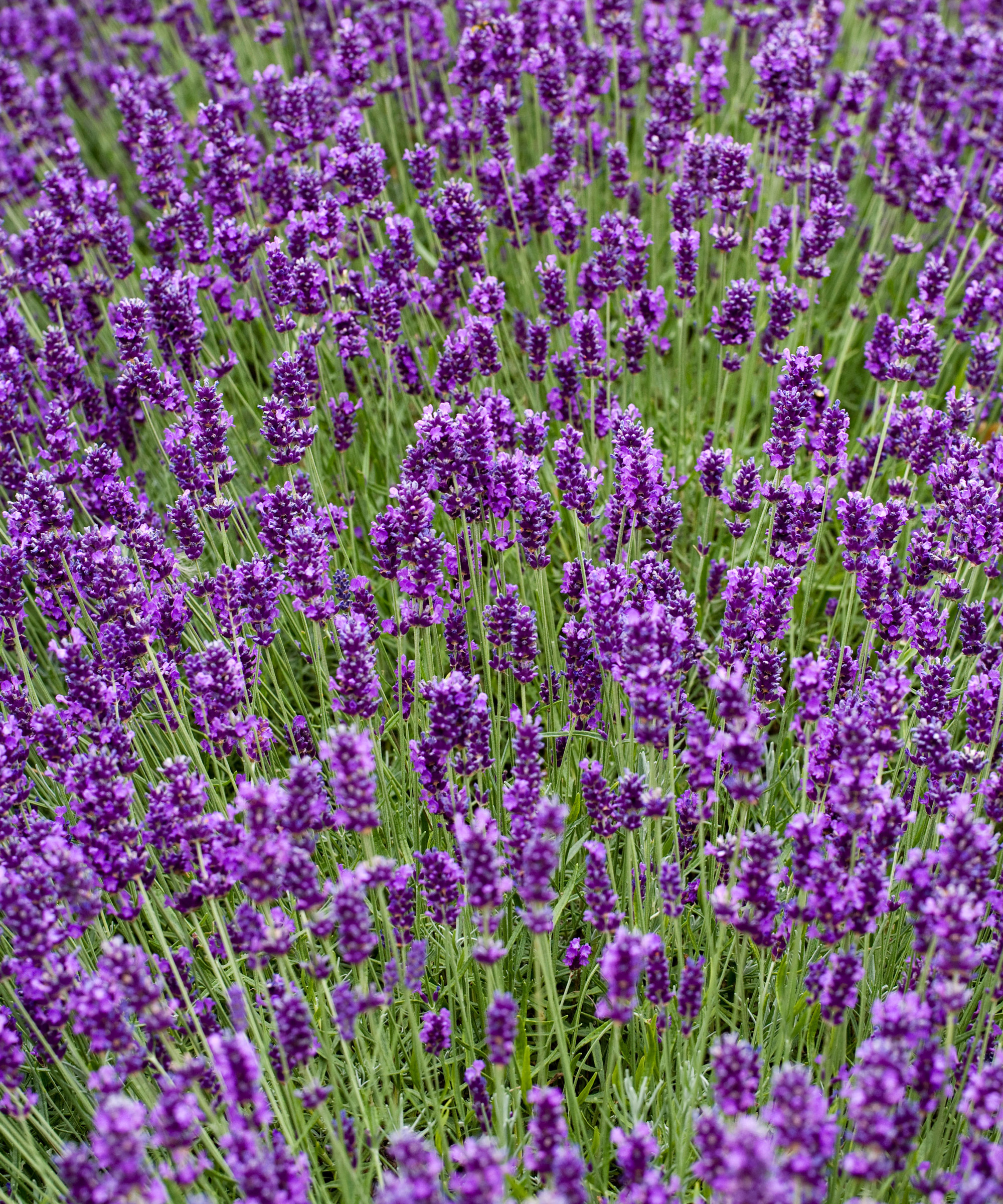
- Hardiness: USDA 7b/8a
- Height: 18in (45cm)
- Best for: fragrance
For a fragrant boost to your plot, you are encouraged to grow one of the more dramatic types of lavender as part of your garden plantings. Lavandula angustifolia ‘Hidcote’ AGM is a bushy and compact cultivar of English lavender and deservedly popular for its aromatic silvery-grey leaves and spikes of deep violet-purple flowers.
Despite the name, these lavenders originate from Mediterranean regions and are usefully drought-tolerant. Try landscaping with lavender to make clumps of flowers or low hedges, and then clip either directly after flowering or in spring in order to maintain the best bushy fragrance.
7. Myrtus communis AGM
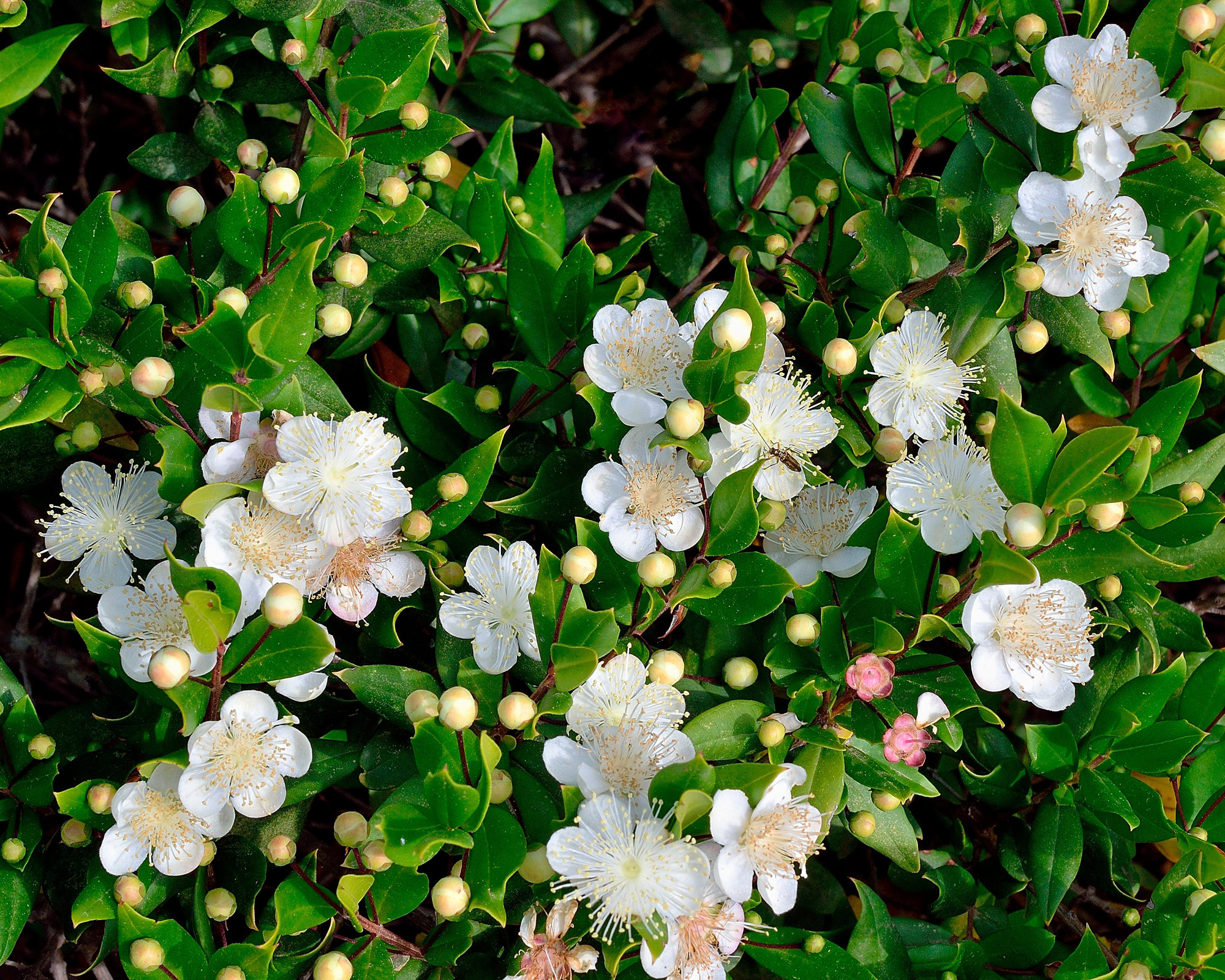
- Hardiness: USDA 8b/9a
- Height: 6ft (1.8m)
- Best for: evergreen foliage
Visit the Alhambra Palace in Granada and you’ll notice hedges of aromatic myrtle, an evergreen shrub with a long history of cultivation in Moorish Spain. Myrtus communis AGM makes one of the best evergreen shrubs for a Mediterranean-inspired planting scheme.
Neat pointed leaves are joined by small white flowers during summer and fall, followed by purple-black berries. These sensitive plants (sometimes known as Corsican pepper) will need good sun to flower but a sheltered site away from frosts and cold winds.
8. Phlomis fruticosa AGM
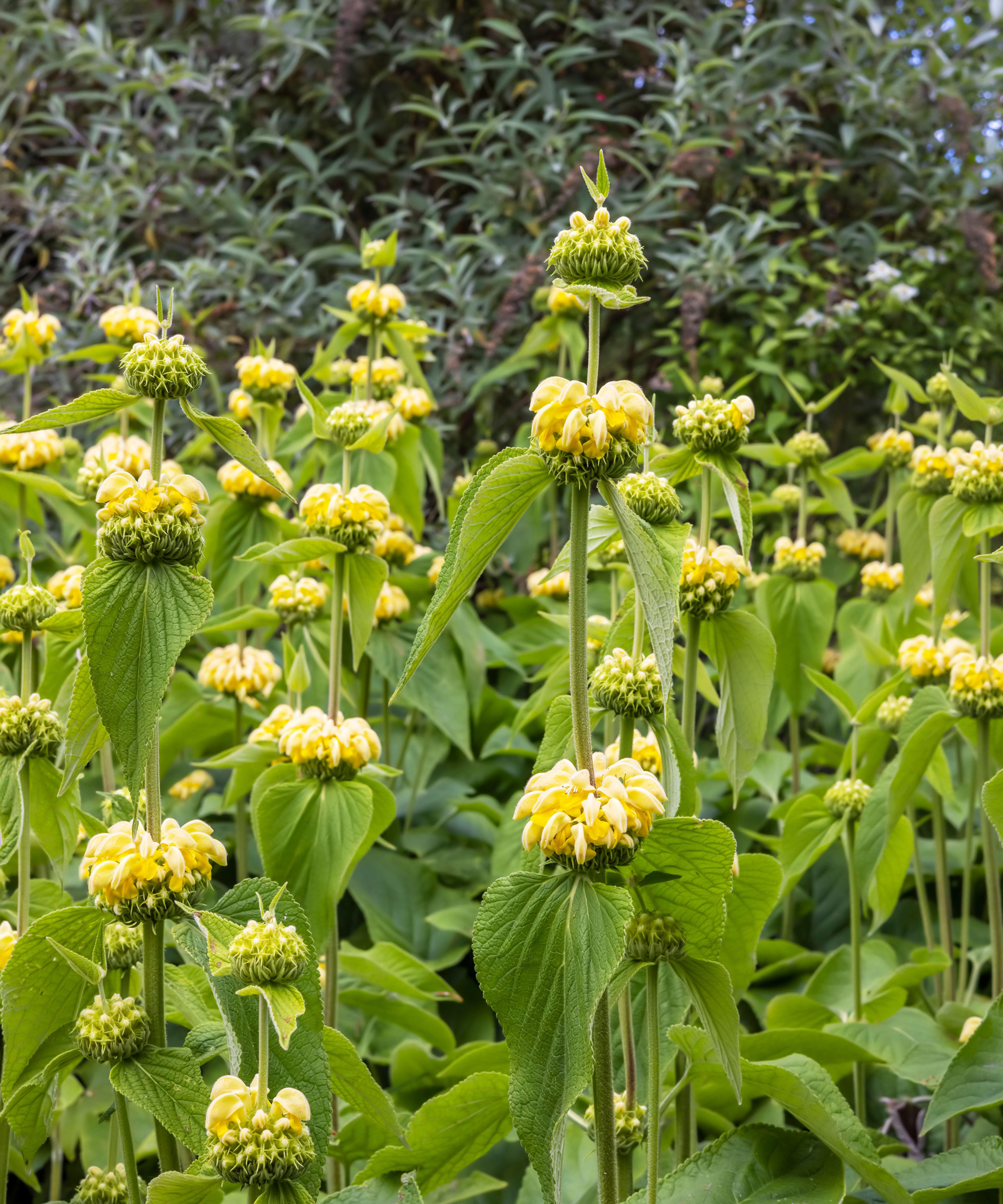
- Hardiness: USDA 6b/7a
- Height: 3ft (1m)
- Best for: yellow flowers
Lovers of yellow flowers will love this next pick. Known as Jerusalem sage or Jupiter’s distaff, Phlomis fruticosa AGM is a small but spreading evergreen shrub, perfectly adapted to survive harsh sun and dry soils.
The hairy, grey-green leaves of this Mediterranean shrub are woolly beneath. They create a soft foil for whorls of sulphur-yellow flowers opening from summer to fall.
Prune in spring but not into old wood, or trim lightly after flowering to keep them at their best.
9. Rosmarinus ‘Majorca Pink’
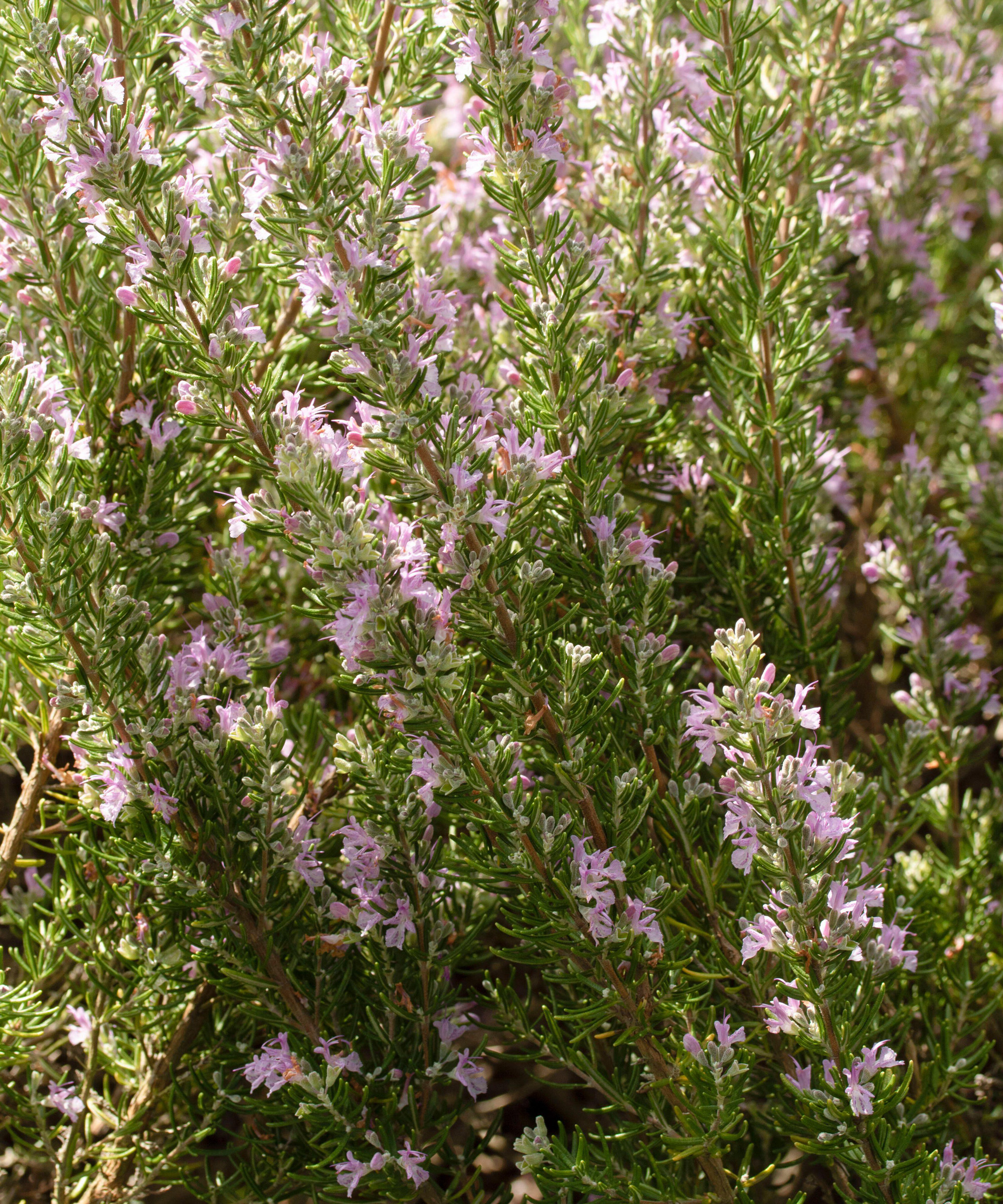
- Hardiness: USDA 8b/9a
- Height: 3ft (1m)
- Best for: herbs
Decorative and useful, evergreen rosemary benefits from regular harvesting to keep bushes compact and healthy. Rosmarinus ‘Majorca Pink’ is one of the most fragrant Mediterranean plants in our selection and ideally suited to sunny container gardening or a border.
While tumbling rosemary types are perfect for the edges of raised beds, this cultivar is upright. It has needle-like leaves and pretty pale pink flowers from late winter to summer. Sun and well-drained soil are essential to get the most from this Mediterranean planting.
10. Campsis ‘Madame Galen’ AGM
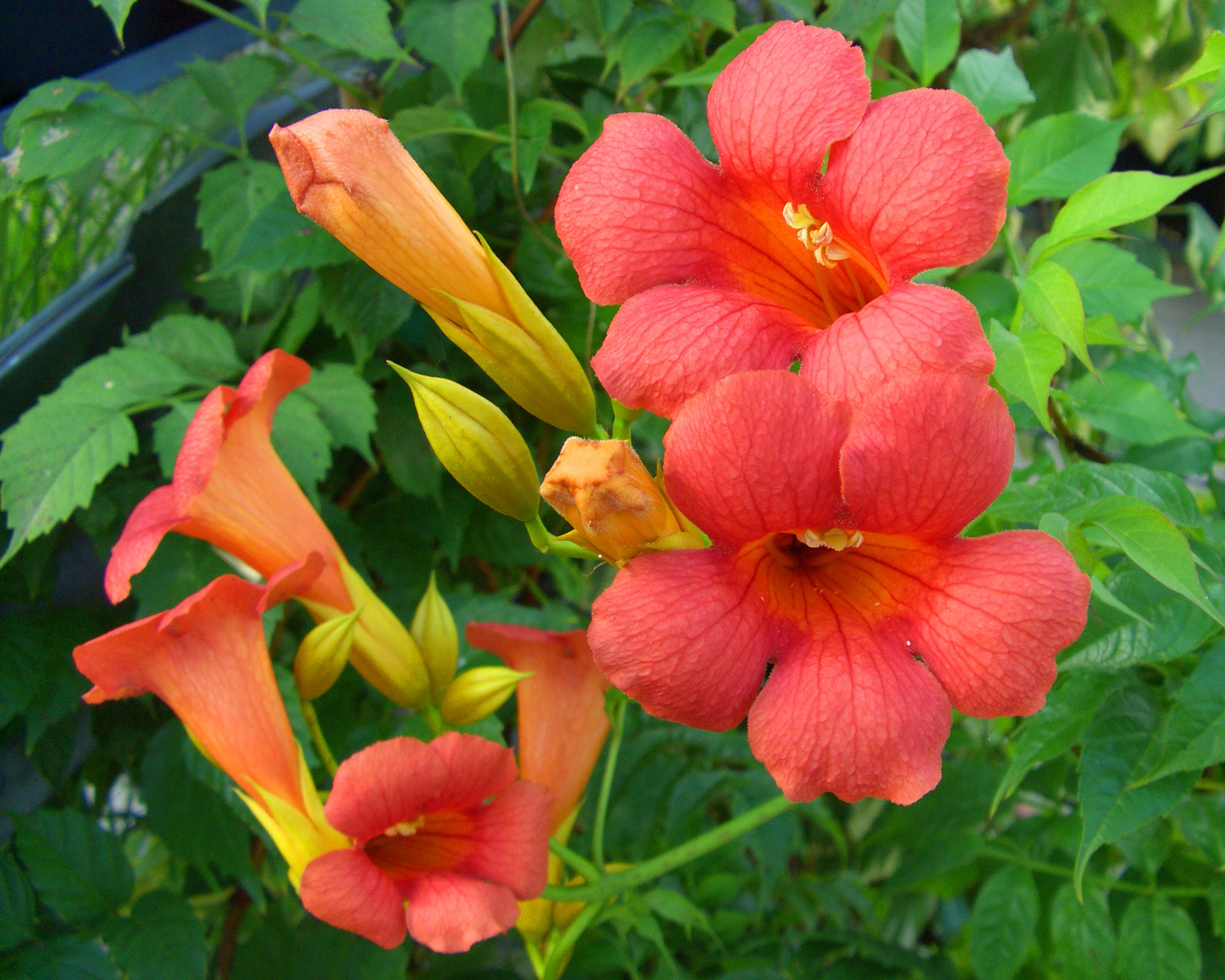
- Hardiness: USDA 8b/9a
- Height: 26ft (8m)
- Best for: south-facing walls
In anything less than a Mediterranean climate, the situation you choose is paramount to coax a top performance from the Campsis x tagliabuana ‘Madame Galen’. Moderately fertile, well-drained soil and a sheltered and sunny garden wall are ideal for this Mediterranean-style climber.
The trumpet vine, as it is also known, clings by means of aerial stem roots. Pinnate leaves (with many leaflets) act as a foil to clusters of large, trumpet-shaped orange-red flowers from late summer to fall.
11. Rose ‘Claude Monet’ Climber
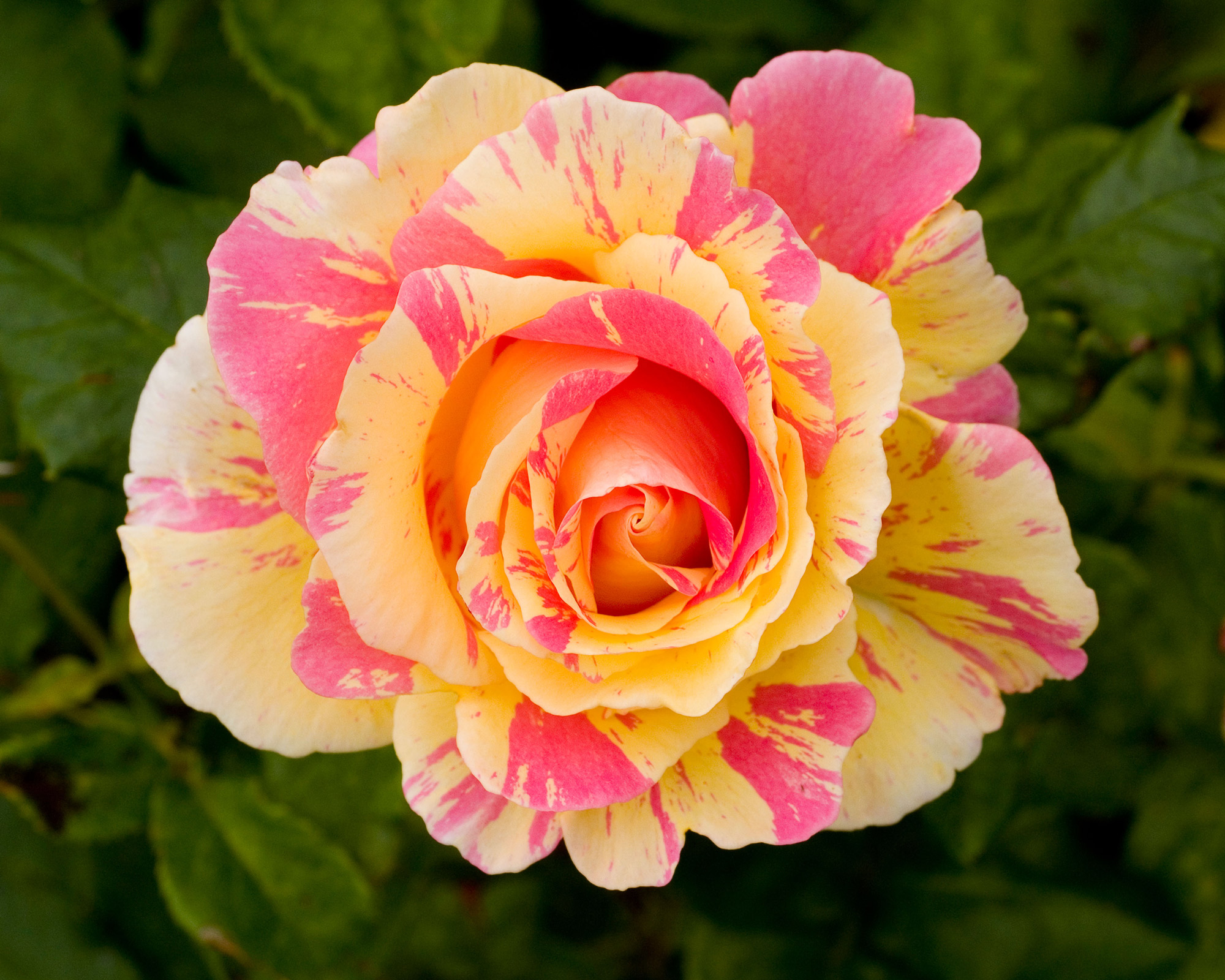
- Hardiness: USDA 6b/7a
- Height: 8ft (2.4m)
- Best for: climbing roses
Rose lovers who are after the best climbing roses as part of their Mediterranean planting scheme should consider Rose ‘Claude Monet’ Climber. Popular in Mediterranean gardens, this modern climber is a healthy choice with good tolerance of poorer soils.
The large fragrant, double bi-colored flowers of pink, yellow and white are unlikely to fade significantly in the sun.
With well-timed deadheading, they bloom from early summer into the fall.
12. Trachelospermum jasminoides AGM
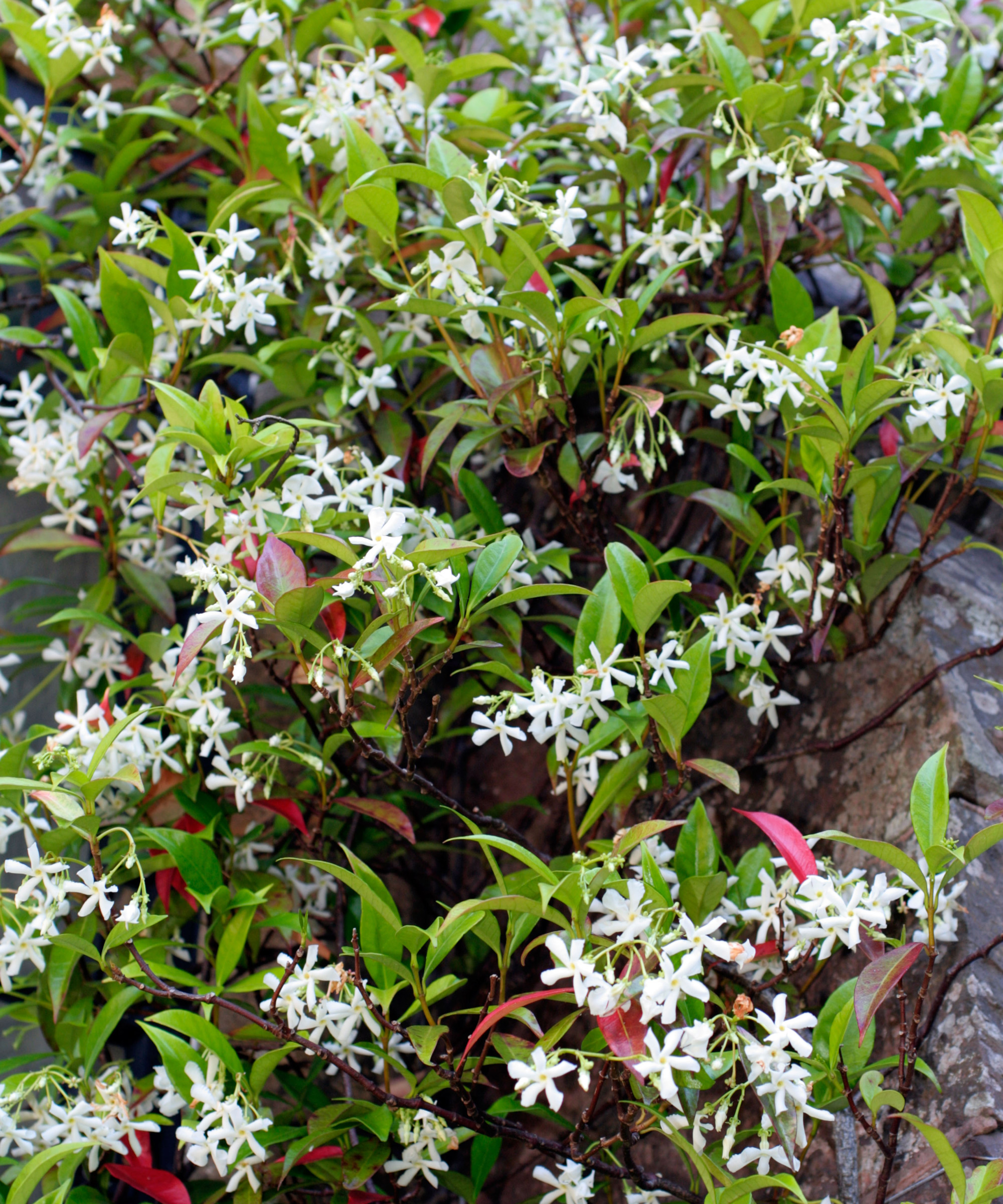
- Hardiness: USDA 8b/9a
- Height: 20ft (6m)
- Best for: large containers
This evergreen twining climber is known as star jasmine, but is more closely related to hoya and stephanotis. And if you are looking for the best climbing plants for a Mediterranean garden, Trachelospermum jasminoides AGM is a gorgeous glossy self-twining shrub.
Deservedly popular, these perform best in a sheltered spot in sun or partial shade, on good, well-drained soil. Plants will also thrive in generous-sized containers. Pretty windmill-shaped white flowers open in summer and are sweetly fragrant.
13. Vitis ‘Fragola’
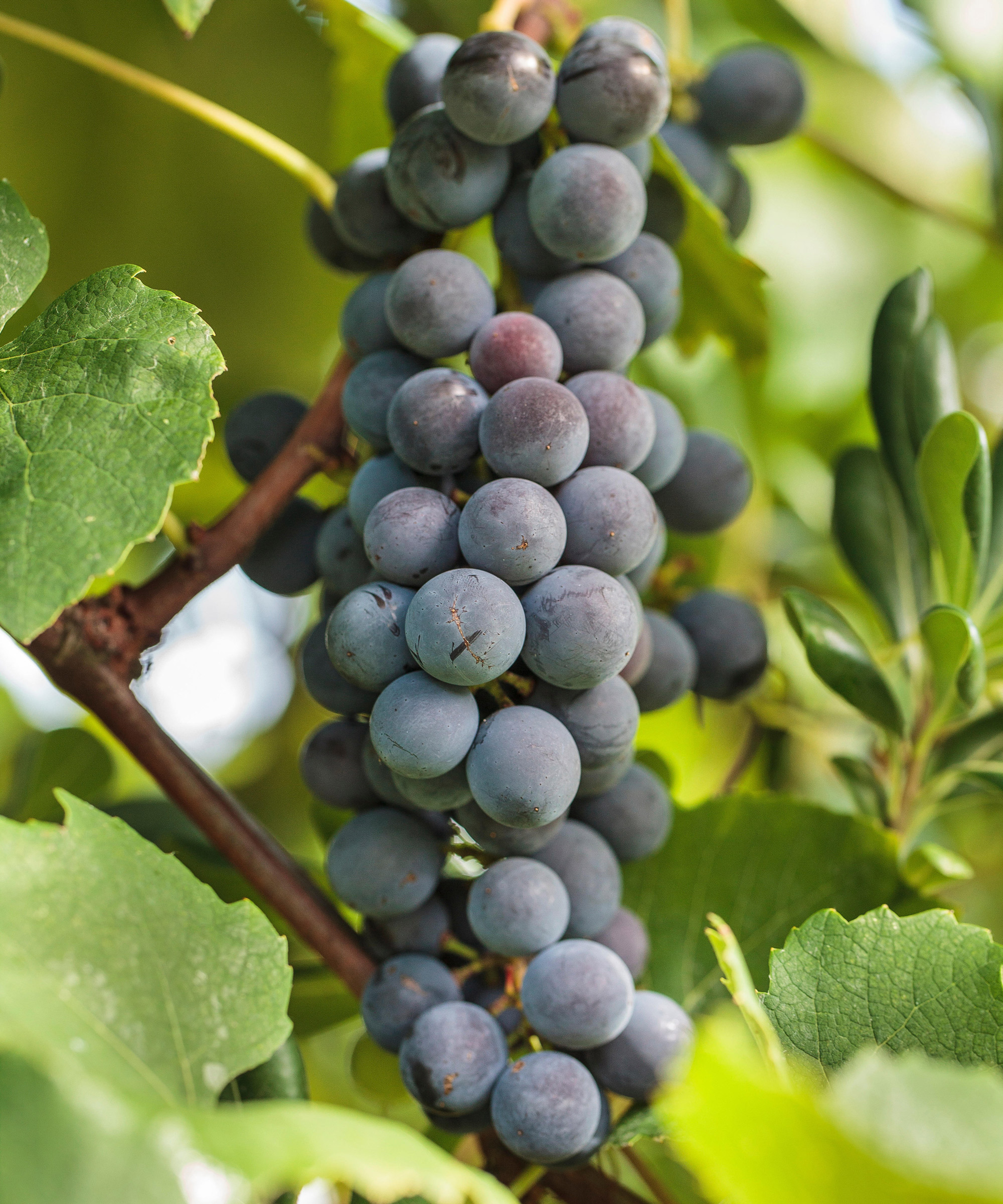
- Hardiness: USDA 7b/8a
- Height: 26ft (8m)
- Best for: climbing fruit
The strawberry vine produces bunches of sweet amber-red grapes, suitable for both wine making or eating raw. This vigorous grape is one of the best fast-growing climbing plants, as well as an attractive and fragrant addition to a Mediterranean garden.
Vitis ‘Fragola’ is amongst the most dramatic and fragrant options. The foliage is attractive and turns yellow in autumn. Not everyone has room for a vineyard (ideally sited halfway up a south-facing slope) but most can train a vine to cover a pergola or south-facing wall.
14. Butia capitata AGM
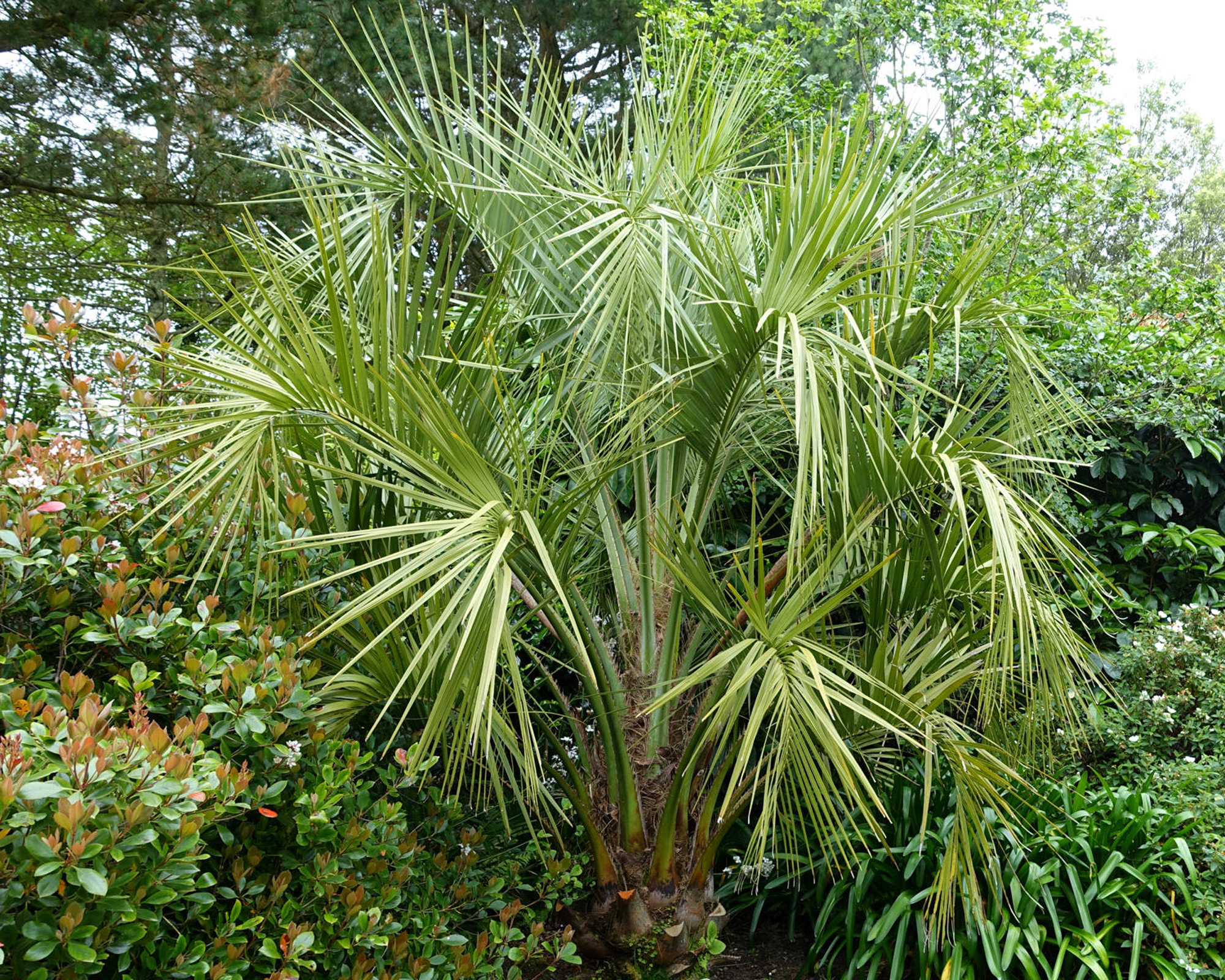
- Hardiness: USDA 3
- Height: 12ft (4m)
- Best for: cold tolerance
As well as being perfect for striking tropical garden ideas, palms are also some of the most dramatic Mediterranean plants you can grow. Native to South America, the elegant jelly palm (Butia capitata) bears long silvery-grey feather-shaped leaves.
All but those in the warmest and most sheltered parts of the UK will have to take a risk or keep their palm in a pot and move it to more sheltered accommodation for the winter. However, these palms do become more cold-tolerant with maturity.
15. Chamaerops humilis AGM
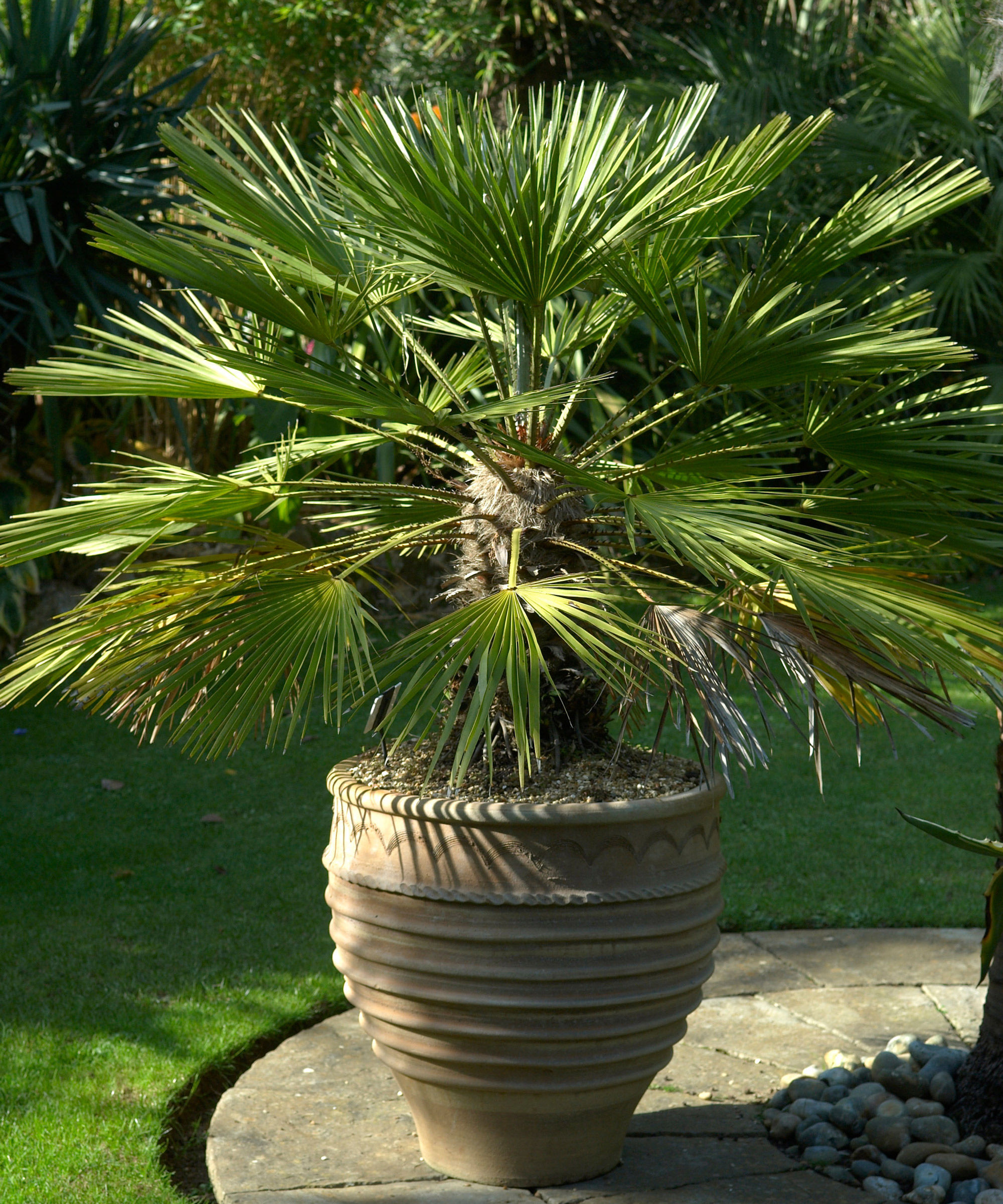
- Hardiness: USDA 8b/9a
- Height: 6ft (1.8m)
- Best for: drought tolerance
Also known as the European fan palm or the Mediterranean dwarf palm, Chamaerops humilis AGM is amongst the most architectural plants in this selection. It's also incredibly tough, resilient and well-adapted to rocky soils.
The large fan-shaped leaves of this striking palm are divided into 20 or more segments, held out from short fibrous trunks on pale stems. Whether grown in a container or planted in well-drained soil, this majestic plant will benefit from a sheltered courtyard.
16. Trachycarpus fortunei AGM
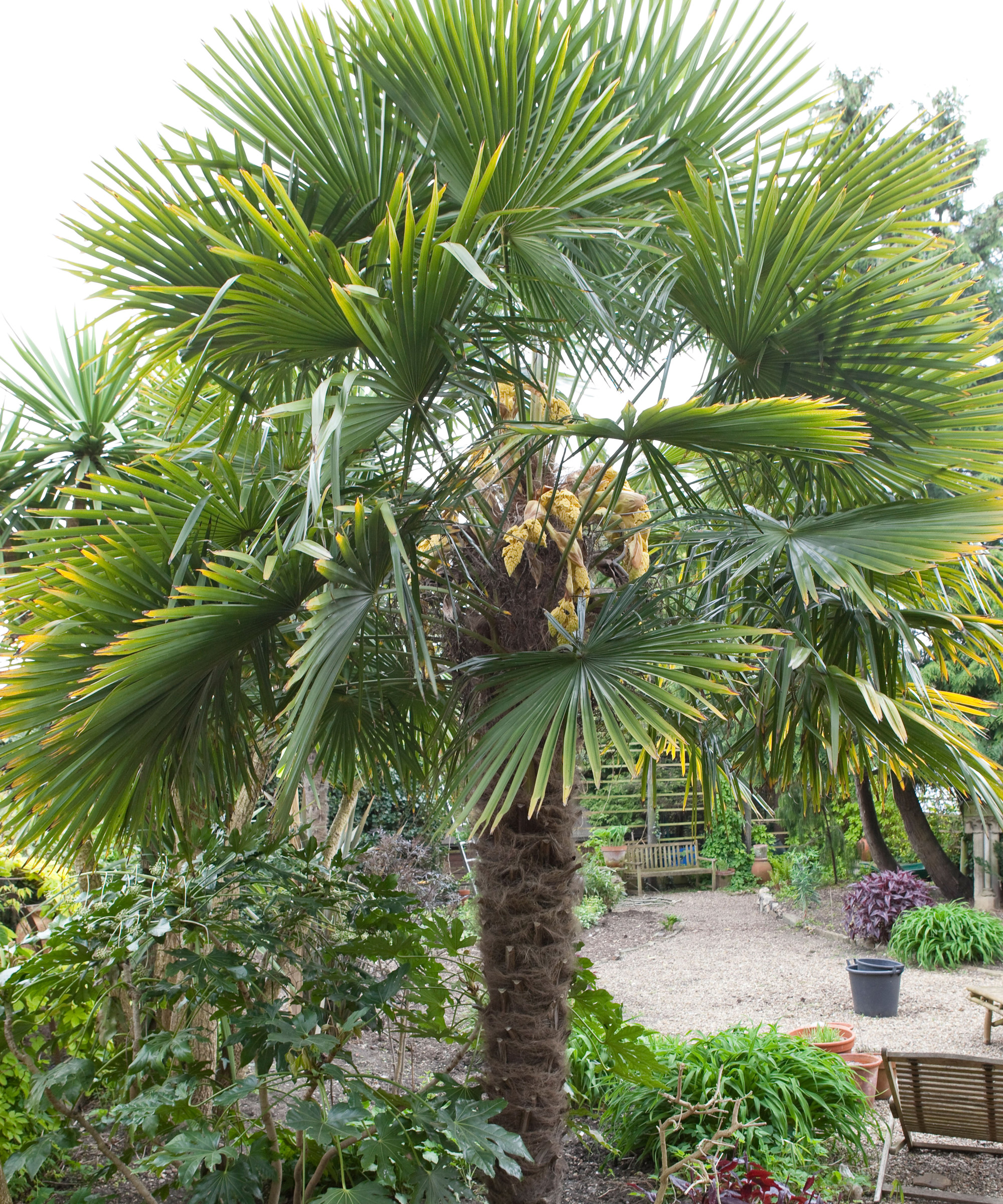
- Hardiness: USDA 7b/8a
- Height: 30ft (9m)
- Best for: low-maintenance trees
The Chinese Chusan palm or windmill palm is a popular choice for planting outdoors in the UK. So if you are looking for the best low maintenance trees to complement your Mediterranean plantings, Trachycarpus fortunei AGM is an ideal choice.
In a sheltered position and well-drained soil, it is possible for specimens to tolerate surprisingly cold hard winters. Over time, fan-shaped leaves 3ft (1m) wide become held aloft, as leaf stem bases stack up to produce a trunk on these impressively shaped plants.
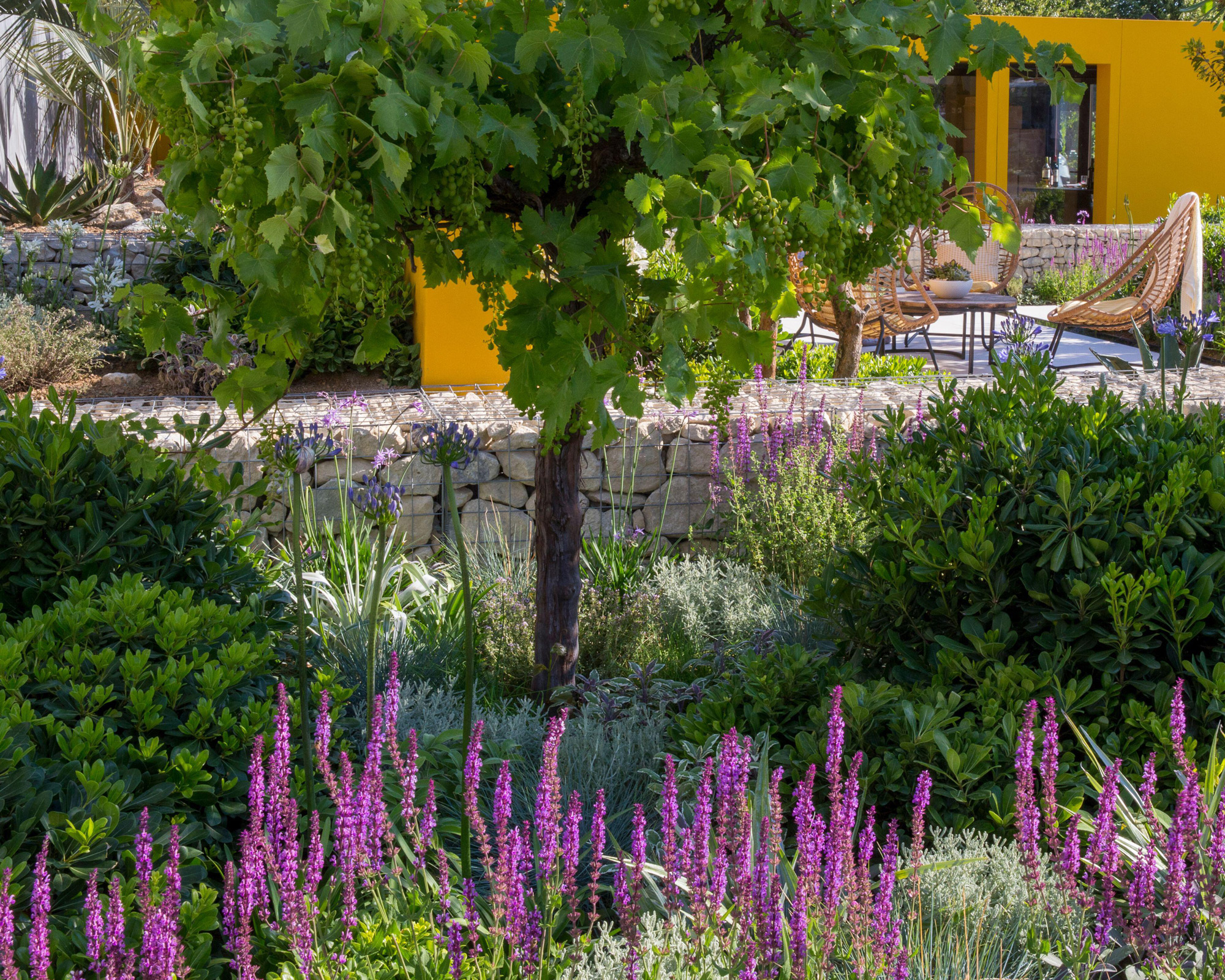
Which Mediterranean plants give the best flowers?
Well-positioned pops of color can bring Mediterranean plantings to life. Think first about height and shape, and second about vibrant bloomers. Having selected structural trees and shrubs, fill in with flowering plants to bring banks of color, or use the dynamism of individual blooms. Informal Mexican Erigeron karvinskianus will seed into cracks and crevices to open pink and white daisies. Californian poppies (eschscholtzia) are also easy to grow from spring-sown seed.
Add bedding types for summer color, including cultivars of Cleome hassleriana, a tall South American plant known as spider flower. If you are looking for flamboyant courtyard garden ideas, stand pots of pelargoniums on steps. Exotic-looking birds of paradise (Strelitzia reginae), bougainvillaea and blue-flowered Plumbago capensis will need winter protection from one year to the next.
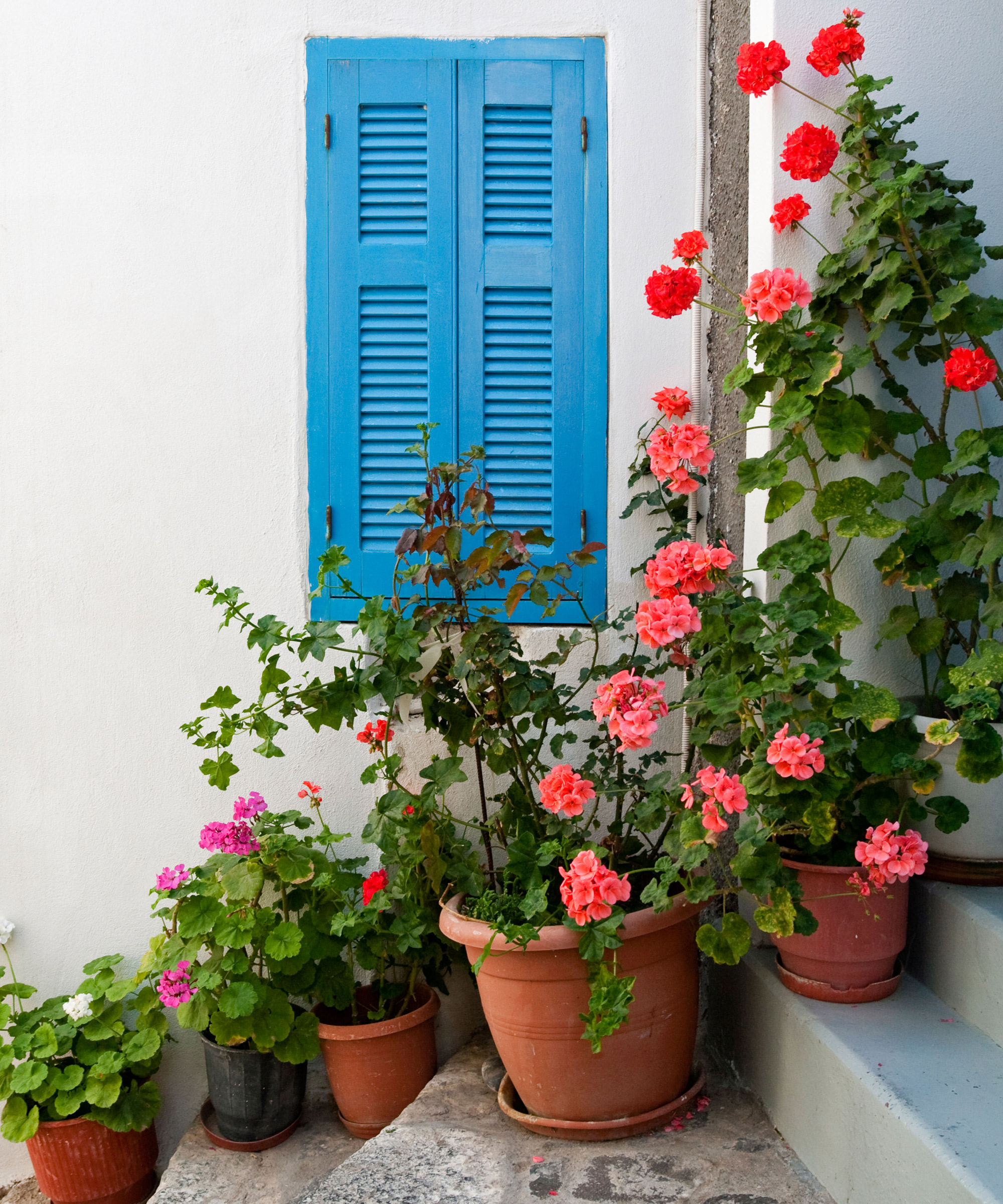
Which herbs make the best Mediterranean plants?
If you are after the best herbs to grow in your garden that will conjure up that distinctive far-flung fragrance, consider combinations that complement both the big shrubs and delicate blooms planted elsewhere.
Mediterranean herbs include shrubby rosemary and sage (Salvia officinalis) for grey-green leaves and tasty purple flowers. There is also purple sage, golden sage (S. officinalis ‘Icterina’) and tricolored sage. Thyme (Thymus vulgaris) and lemon thyme (T. citriodorus) make low, spreading mounds covered in heads of small, pretty flowers in summer.
Marjoram (Origanum majorana) and Greek marjoram (O. vulgare subsp. hirtum) are best described as woody-based perennials.
Fennel (Foeniculum vulgare) makes a tall, feathery perennial topped with heads of small yellow flowers. All these herbs attract many pollinating insects.
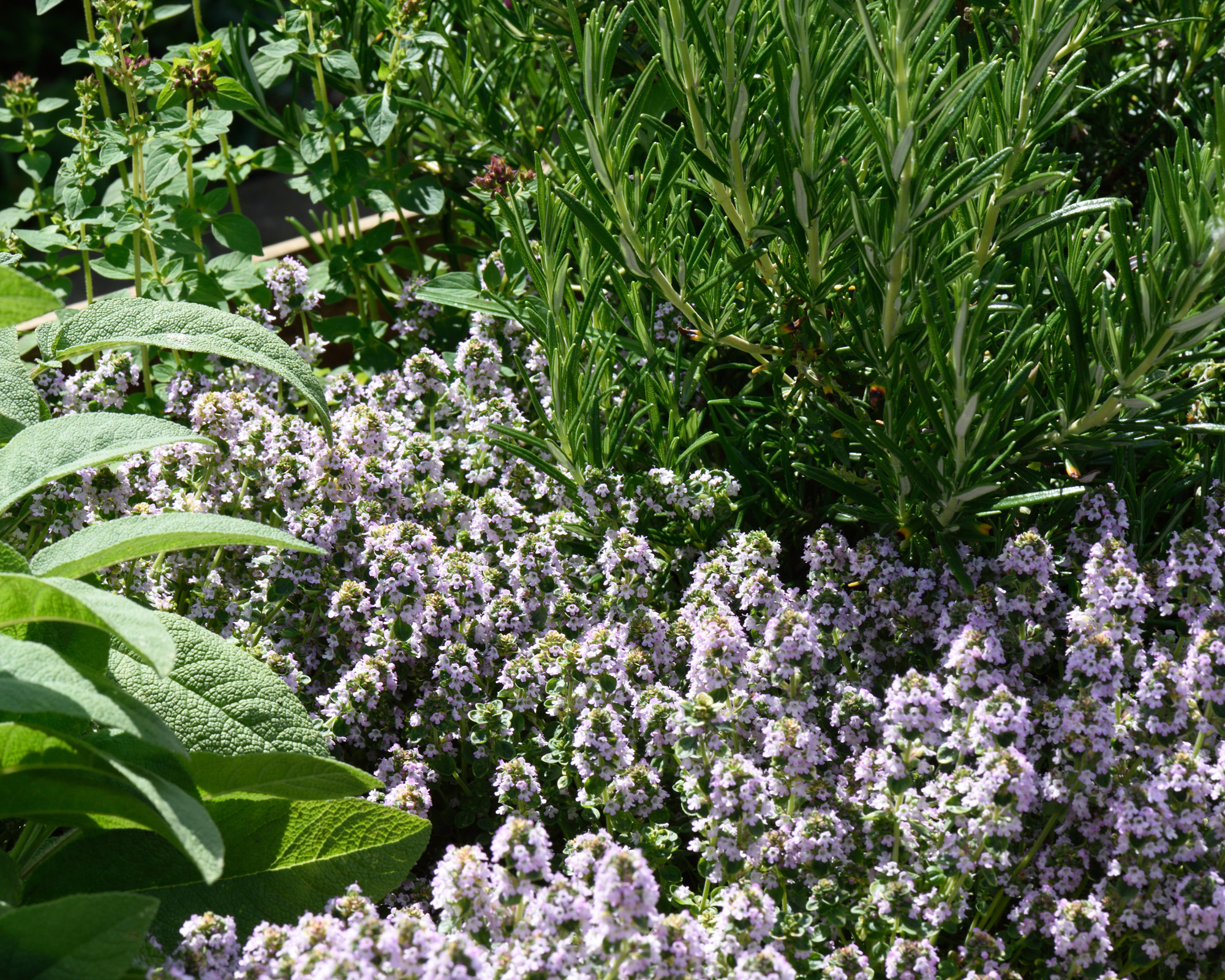
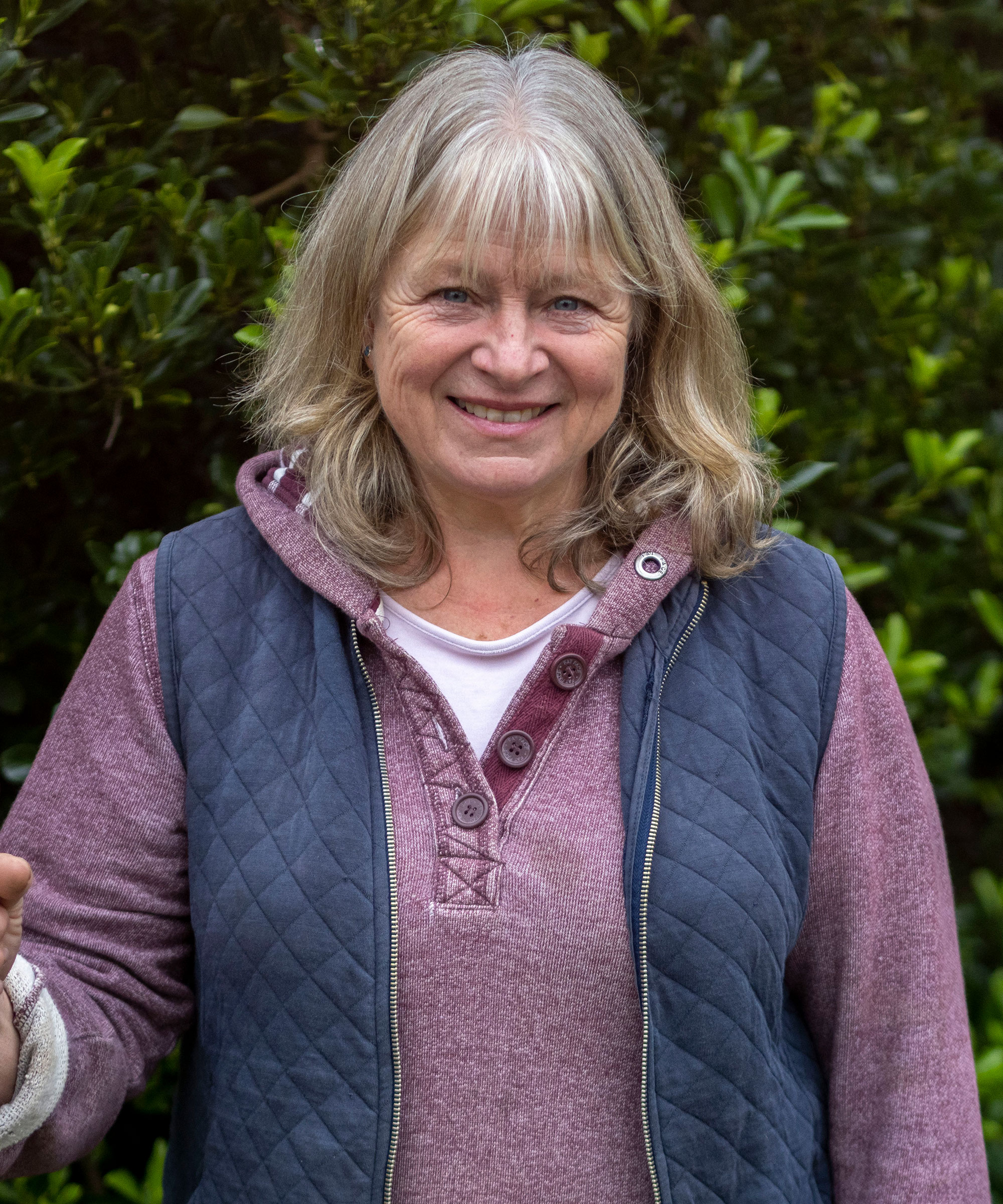
Having trained at Kew Gardens in London, worked in parks department nurseries and as Glasshouse Supervisor at RHS Wisley, Anne has been a freelance horticulturist since 1986. Anne writes for Amateur Gardening and has been a regular panelist on BBC Radio 4’s Gardeners’ Question Time for 27 years. A large plot full of wildlife habitats, edible and ornamental plants is Anne’s workshop and inspiration.
